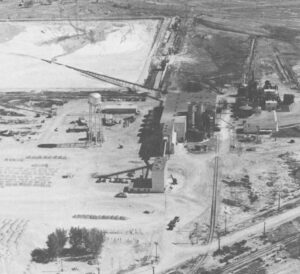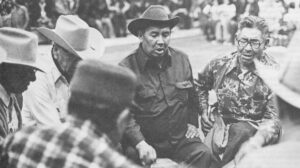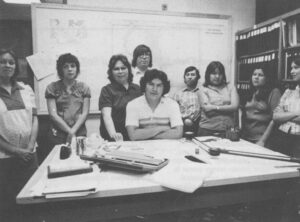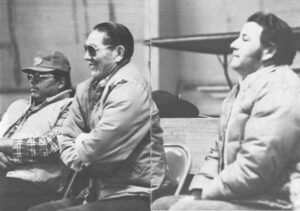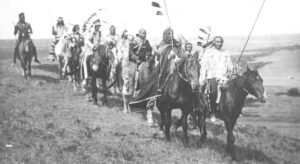(SHIPROCK, NM) — Grace Begay can’t leave her husband, Steven, 64, alone. She follows him around the house, afraid that he’ll black out again with no one there to help him. As he sits patiently describing his symptoms in Navajo through an interpreter, he holds his arms crossed to still the otherwise constant tremor in his hands. He has seen eight doctors in the past 17 years, none of whom can figure out what’s wrong with him.
For 10 years Wallace Martin, also a Navajo, has known there is something wrong with his lung. When he tries to walk faster, he has trouble breathing. Doctors kept telling him there was nothing wrong with him until finally they saw the evidence of silicosis in his lung. “That uranium got me,” he says.
Henry C. Bearing, an Arapahoe Indian in Ethete, Wyoming, also has trouble breathing sometimes and says he has felt “lazy” and lethargic for several years.
Most of Bob Haddenham’s hair has grown back, and he no longer blacks out in the middle of sentences, but his bitterness has not abated. A resident of Riverton, Wyoming, he believes the Eisenhower Administration used him and his co-workers as guinea pigs to test the effects of radiation, and he has devoted his limited energy in recent years to completing a file that his wife can use to get compensation after he dies.
While these men and others who worked in uranium mills 15-20 years ago suffer hundreds of miles apart, they have a lot in common. At least partially disabled, they share many of the same symptoms — unexplained blackouts, skin sloughing off, constant fatigue, asthma, chronic bronchitis and susceptibility to colds.
When they blame their afflictions on their uranium mill work they are written off as kooks or just looked at skeptically by peers and professionals. Until now, they have hesitated to even try for compensation because most of their symptoms showed up years after they completed their work at the mills.
Doctors, confronted with a confusing array of symptoms, tell them they’re diabetic or epileptic or not sick at all. If they are Indian, some people assume their health problems stem from excessive use of alcohol.
Lawyers won’t take compensation cases without statements from doctors saying the ailments were caused by their jobs. But because working conditions in the mills were so much better than in the dogholes the miners worked in, almost no health studies have been conducted on mill workers. So even sympathetic doctors don’t have research to back them up.
However, finally someone is listening and saying that their special problems should at least be further investigated. Dr. Leon Gottlieb, a pulmonary specialist formerly with the Shiprock Public Hospital in New Mexico, backed by Joseph Wagoner, a Public Health Service researcher in Washington D.C., has convinced Stewart Udall, former Secretary of the Interior, to represent two Navajo mill workers. William Tsosie and Elvin D. Smith have now joined the 65 uranium miners who are suing the federal government and uranium companies for compensation.
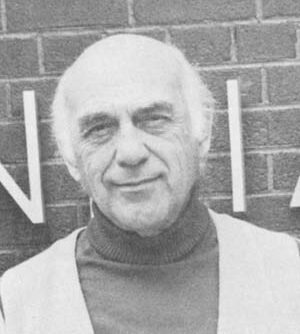
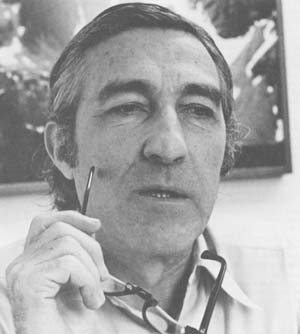
Like the miners, these men helped to produce uranium for the nation’s nuclear defense program in the 1950’s and ‘60s. After the miners dug uranium out of the ground, it was sent to nearby mills to be crushed, ground, treated chemically with acidic or alkaline solution and extracted from the solution. The final product, yellowcake (U308), was then dried and packaged for shipping to enrichment plants in the East. Then, as now, most of the mills were located in New Mexico, Colorado, Utah, Arizona and Wyoming; Mex-several were then on land bought or leased from Indians — Riverton, Wyoming; Mexican Hat, Utah; Shiprock, New Mexico; and Monument Valley and Tuba City, Arizona. Many mills, including these five closed down in the ‘60s after the nation had stockpiled enough uranium for its defense program and before there was much demand for fuel for nuclear power plants.
The number of millworkers who became disabled during that era doesn’t approach the number of miners, 600 of whom have been screened by the Shiprock Hospital alone. But Udall and community health representatives on the Navajo Reservation are convinced there are many more than have surfaced so far. While some have been disabled for years, others have only recently gotten cancer because of the long latency period typical of the disease.
When Udall began investigating the potential for a mill workers’ suit, he found that in the late 1940s, when people first became alarmed about uranium workers’ exposures to radiation, they were concerned about both mines and mills. It was only later, when both money and investigating manpower were scarce, that the spotlight focused exclusively on the miners.
The mill investigation got off to a bad start. A front page story in the Denver Post on July 8, 1949, on an inspection of the Naturita uranium mill was headlined “A-Plant Fumes Lethal in Hour, say Officials.” The article created such a furor that, according to a memo by Duncan A. Holaday, an industrial hygienist with the U.S. Public Health Service, it was “unadvisable” to survey the other uranium mills at that time. The article described mainly the toxic chemicals in the air, but as a result of the story, several workers from Naturita and other mills wrote to the Colorado health department inspector describing symptoms that indicated silicosis (scar tissue in the lungs) or radiation poisoning.
When other mills were subsequently surveyed, operators were assured the information would not be released in the newspapers. The reports are now stored in the files of the National Institute for Occupational Safety and Health, but according to NIOSH officials, “Great care was taken not to identify the mills.” Consequently, the reports are of little use in litigation.
Holaday, who conducted many of the inspections, has since retired. Except for silicosis, he doesn’t expect that mill workers contracted disease from their work. The dust in the mills, which under certain conditions could cause lung cancer and other diseases, was not that difficult to control, Holaday now says. “Most of the mills did a beautiful job after we ran a few courses for their people on ventilation,” he says.
However, some of the older mills — Naturita, Rifle and Uravan — which had been operating since the 1920s were notoriously dirty, he says. “What they needed most was a new plant.”
“Most of the mill operators were trying, but they weren’t really competent…. They put in fancy ventilators that just got all the dust circulating because they hadn’t bothered to clean up first. One place we offered to put in a ventilator for free if we could just keep the dust that they lost out of their stacks each day,” Holaday says.
The mill at Shiprock on the Navajo Reservation was “a real mess,” he says. A few years after it closed in 1968, a Navajo cleanup crew found at least $100,000 worth of yellowcake between two layers of roofing, according to Harold Tso, director the Navajo Environmental Protection Commission. Apparently the dust had settled in the old roof, and no one had bothered to clean it out before a new roof was built over it.
Men who worked at various mills tell of stirring yellowcake with rakes in open, steam-heated floor pans. They were given cloth respirators to cover their noses and mouths, but sometimes they weren’t cleaned, and men would use them still caked with residue from the previous day. Since they often weren’t told that uranium could be dangerous, some men wouldn’t bother to wear the respirators at all. In the early years, workers would eat their food in areas thick with the hazardous dust. Men who worked at the Susquehanna-Western plant near Riverton say that the drinking fountain sometimes wouldn’t work, and when they took it apart, they would discover that it was clogged with yellowcake. One worker said he would take the mandatory shower at work, but the water was so contaminated that he would take another shower when he got home and leave a yellow residue in the bottom of the tub.

As early as 1959 the uranium mill operators and the U.S. Atomic Energy Commission were predicting compensation suits, and the AEC was reportedly cautioning mill operators to avoid providing evidence.
According to a memo prepared by Lew Hazen, a consulting engineer for Susquehanna, Dr. G.V. Beard of the AEC told mill operators not to give employees copies of their radiation tests. Speaking at a meeting of the AEC and mill operators in Grand Junction, Colorado, in April 1959, Beard reportedly said that once you admit an employee has been contaminated with radiation, then you “get into another category and it would cost everybody an awful lot of money to comply with regulations…. Under no circumstances would the AEC tolerate or permit any licensee to admit that any employee had a ‘body burden’ of uranium.”
Hazen’s interpretation of Beard’s remarks imply that he would just as soon not know if someone were exposed to excess radiation. However, Holaday doesn’t believe this is true. While he cannot remember attending this particular meeting, he was familiar with Beard and says Beard was just reminding the operators of the importance of meeting the standards.
However, Hazen’s memo also implies another AEC official gave the operators permission to exceed standards. “Mr. Walker (D.I. Walker of the Division of Inspection, AEC, Idaho Operations Office) said that if a mill could show that concentrations in certain parts of the plant must be higher than MPC (maximum permissible concentrations) he had authority to give, and would give, permission to operate under these higher conditions.”
About 10 years later, some of the mills were closing down. A few mill workers were tested to see if radioactive elements had been deposited in their lungs, but nothing was found. Wagoner and Dr. Victor Archer of the Public Health Service’s NIOSH studied 104 former mill workers who died prior to 1968 and found three more cases of cancer of the lymphatic and hematopoietic tissue than would have been expected. However, since the study group was small, Archer says the results were considered suggestive but not necessarily conclusive.
NIOSH started a larger study of mill workers’ deaths, but it was dropped for several years because of higher priorities, principally the uranium miners. By then attention was focused on radon daughters as the principal radiation problem among uranium workers, and these radionuclei were thought to exist only in the mines.
Now, more than eight years after Wagoner and Archer warned of health problems peculiar to mill workers, the government is resuming its studies of this occupations’ hazards. The Nuclear Regulatory Commission has just funded McDonald E. Wrenn of the University of Utah Medical School to study lung tissue from mill workers who have died. NRC says the study is routine, confirmatory biological research, which, it points out, was proposed by Wrenn — not the NRC. Wrenn, however, says that the radiochemical techniques he will be using are much more sensitive than previous methods and may find evidence of contamination that earlier studies of live workers’ lungs missed.
Coincidentally, Dr. Richard Waxweiler of NIOSH is continuing the agency’s study of mill workers’ deaths that was dropped several years ago.
Wagoner thinks it is about time. The fact that the U.S. government has not conducted more research is evidence that it has been negligent in its responsibility to protect people from radiation, he thinks. In light of the biological evidence already accumulated, he thinks additional studies are also needed to examine all health effects in mill workers.
Such studies are crucial to attempts to get compensation for the mill workers. While the health effects of radiation have been widely studied, the research has not found diseases peculiar to this cause. In other words, the victims get lung cancer, leukemia, bone cancer, skin cancer, but so do people who are not exposed to excesses of radiation. They also age faster, and their natural immunities to other diseases are broken down.
As the AEC told Congress in 1960, “It is impossible for a workmen’s compensation program to provide compensation for all cases of occupationally connected diseases or disabilities without also providing compensation for non-occupationally connected cases of disease or disability in several major classes of diseases.”
Consequently the burden of proof is on the employee to show the connection.
While these new research efforts and Udall’s suit are hopeful signs to some of the disabled mill workers, they realize the benefits — if any — are several years away. Their numbers are smaller and generally speaking, their problems less severe than the miners’. So for now, they must wait their turn for medical and legal attention. Udall and his associates have all they can do to represent the miners and fallout victims now, and the Indian Health Service staff in Shiprock has been strained beyond its limits just to screen all the miners who have shown up. Funding ran out a few weeks ago for Dr. Gottlieb, whom Udall refers to as a medical missionary for the Navajo people. Gottlieb is well liked and respected by the uranium victims, who circulated petitions asking that the IHS extend his stay. But the IHS could no longer pay him, and in fact other staff cuts were necessary because of the costs of screening the miners, according to Dr. Neil Gordon, chief of medicine at the Shiprock Hospital.
“The horror of this is that it isn’t over,” Udall says. “We can’t just say we’ve picked up the wreckage and it’s over. I just got a call yesterday saying another Navajo miner had died. The work is going to go on and on…. We just must be patient.”
©1980 Marjane Ambler
Marjane Ambler is investigating “Indian Energy Policies and Their Effect on Tribal Self-Sufficiency.”

